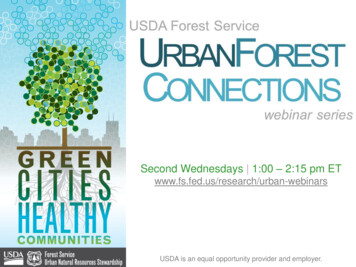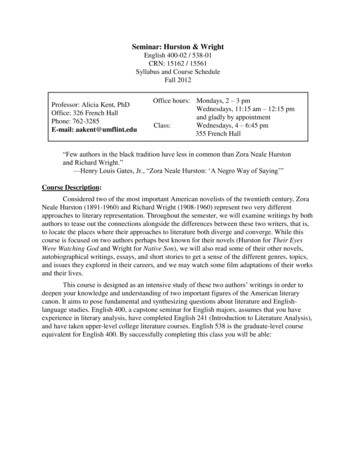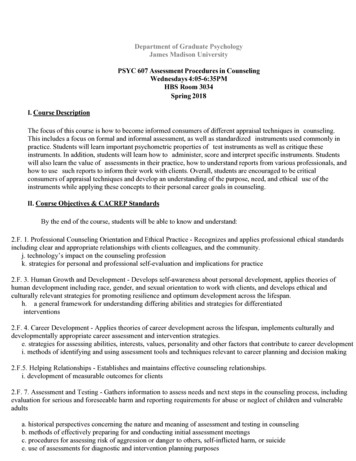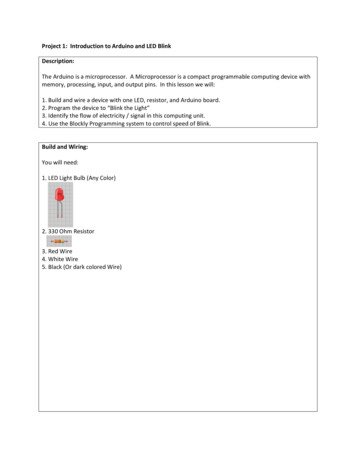
Transcription
Second Wednesdays 1:00 – 2:15 pm ETwww.fs.fed.us/research/urban-webinarsUSDA is an equal opportunity provider and employer.
Andrew TirpakLyn RutherfordPostdoctoral Researcher, Department ofCivil and Environmental EngineeringUniversity of Tennesseertirpak@vols.utk.eduSustainable Landscaper, Water QualityProgramCity of Chattanooga, TNlrutherford@chattanooga.gov
More ThanGood Looks:How trees influenceurban stormwatermanagement in greeninfrastructure practicesAndrew Tirpak, PhDPostdoctoral Researcherrtirpak@vols.utk.eduJon Hathaway, PhD, PEAssistant Professorhathaway@utk.eduUrban Forest Connections Webinar SeriesMay 8, 2019
Urban Stormwater Challenges Impervious surfaces limit infiltration, increase runoff quantity deliveredto receiving waters, leading to degraded stream conditions Pollutants associated with urban areas (sediment, nutrients, heavymetals) impact chemistry and aquatic ecosystems of receiving watersIntroduction
Bioretention Practice: OverviewIntroduction
Livesley, S. J. et al. (2016)
Livesley, S. J. et al. (2016)
Knowledge Gaps Many studies are limited to grasses,shrubs, and sedges, leaving the need toexplore other plant types in bioretention Few studies have explored the specificrole of trees in bioretention Very little research has produced guidancefor tree species selection based onphysiological aspects that may account forperformance contributionsIntroduction
Research OverviewStudy 1Field health survey of trees in existingbioretention practices in Tennessee andNorth CarolinaStudy 2Field-scale study of two suspendedpavement systems designed to function asbioretention practicesIntroduction
Bioretention Tree Health Surveys June-August ‘15 38 practices 97 trees from 22species Six speciesaccounted for 75% of totalStudy 1: The Health of Trees in Bioretention Practices
Crown Condition IndicatorsVigor ClassCrown DensityFoliar TransparencyCrown DiebackRating Crown Condition IndicatorsDensity/Transparency ScaleStudy 1: The Health of Trees in Bioretention Practices
Composite Crown Indicators (CCI) Tree health based on 3D crown shape: Crown Volume Crown Surface Area Larger CCI Values Increased Tree HealthZarnoch et al. (2004)Study 1: The Health of Trees in Bioretention Practices
How does the health of bioretentiontrees compare to other urban trees?Study 1: The Health of Trees in Bioretention Practices
Bioretention vs. Non-bioretention TreesStudy 1: The Health of Trees in Bioretention Practices
Comparing Tree Health Many species were less healthy in bioretention Incompatibility with species-specific growingpreferences for soil moisture, texture, etc.SpeciesSoilpHBald Cypress4.5-6.0Pin Oak4.5-6.5River Birch3.0-6.5Red Maple4.7-7.3Redbud5.0-7.9Lacebark Elm4.8-7.0Saturated orvery wet soilMoist, welldrained soilOccasionallydry soilVery drysoilBassuk et al. (2009)Study 1: The Health of Trees in Bioretention Practices
Comparing Tree Health Eastern redbud: notfound in sandy soils River birch: prefertight clay soils, highsoil moisture Pin oak: found inheavy-textured, poorlydrained soils Bald cypress: bestgrowth in moist, finesandy loam soilswithout competitionStudy 1: The Health of Trees in Bioretention Practices
What bioretention parametersinfluence tree health?Study 1: The Health of Trees in Bioretention Practices
Factors Influencing Health Species selection Soil pH Soil Chemistry Nutrients, metals Soil Composition % Sand, % Fines, OM Bioretention Design Surface Area Tree planting location Ponding DepthStudy 1: The Health of Trees in Bioretention Practices
High-Importance Design ParametersCategoryPredictor VariableSand (%)Reinforces findings in tree health comparison study;media should align with species-specific habitatpreferencesOrganic Matter (%)Influences soil fertility, structure; OM standards varyFines emistryBuffer pHControls fluctuations in soil pH which could impact rootfunction; influences nutrient availability in mediaCopperMicronutrient; deficiency leads to crown defoliation anddieback (other micronutrients are also key)PotassiumTree Selectionand PlantingCommentsVital to plant functions (photosynthesis, waterregulation, cell expansion); required in large amountsPlanting LocationShould reflect tree tolerance to inundationSpecies SelectionSpecies should be tolerant of bioretention environmentStudy 1: The Health of Trees in Bioretention Practices
Tree Health Survey Conclusions1. Trees should be selected based on theirability to tolerate the unique conditionsfound in bioretention practices. Speciesspecific preferences for growing conditionsshould be considered during selection.2. Species selection should be guided byanalysis of bioretention media composition,prioritizing high-importance parameters.Study 1: The Health of Trees in Bioretention Practices
Suspended Pavement Systems Introduction Urban soil conditions present challenges to tree, rootgrowth High compaction, low nutrients, poor aeration (Craul et al., 1985) Suspended pavement systems improve root access to airand water in an uncompacted soil matrix; take advantage oflimited land availability in ultra-urban landscapes Very little research on suspended pavement systemsdesigned as subsurface bioretention to-date Suspended pavement system lined with impermeable membrane inWilmington, NC (Page et al., 2015) Peak flow rates reduced by 62%; significant pollutant removal Lined system may not be applicable to installations outside researchStudy 2: Bioretention Suspended Pavement Systems
Construction and InstallationStudy 2: Bioretention Suspended Pavement Systems
Study 2: Bioretention Suspended Pavement Systems
Hydrologic Monitoring ResultsNorth SiteSouth .7 Total of 1922mm of rainfall recorded (median event of 8 mm)between April 2016 and July 2018 146 and 148 storm events collected for north and south sites Exfiltration from upper soil layers may have outweighed lowinfiltration rates of underlying soils 83% of storms completely captured by south site (123/148storms); 79% at north site (116/146 storms)Study 2: Bioretention Suspended Pavement Systems
Pollutant Removal PerformanceMedian pollutant conc. (st.dev.) for ten paired eventsPollutantInfluentEffluentSignificanceTSS (mg L-1)167 (69)6 (21)p 0.05NH4 -N (mg L-1)0.01 (0.01)0.01* (0.00)-NOx-N (mg L-1)0.05 (0.13)0.11 (0.63)-PO43- (mg L-1)0.06 (0.03)0.06* (0.00)-Cu (μg L-1)0.5 (1.9)0.3 (0.08)-Pb (μg L-1)1.6* (0.0)1.6* (0.0)-Zn (μg L-1)7.9 (8.8)7.9 (18.2)-Note: Asterisk (*) indicates that pollutant levels in all ten samples werebelow method detection limit.Study 2: Bioretention Suspended Pavement Systems
Conclusions Suspended pavement systems are effective atreducing runoff volumes Limited storage volume (“bowl volumes”) insuspended pavement systems can lead tooversized practices Sizing criteria may need to be revisited to accountfor small ponding volumes and the soil volumesrequired for tree growth Further research on pollutant removalperformance needed – potentially linked to lowinfluent concentrations and small sample sizeStudy 2: Bioretention Suspended Pavement Systems
Acknowledgements Dr. Jon Hathaway University of Tennessee Dept. of Civil & Environmental Engineering Dr. Jennifer Franklin University of Tennessee Dept. of Forestry, Wildlife, and Fisheries Dr. John Schwartz University of Tennessee Dept. of Civil & Environmental Engineering Dr. Qiang He University of Tennessee Dept. of Civil & Environmental Engineering Funding for this research was provided in partthrough the United States Forest Service (USFS)National Urban and Community Forestry AdvisoryCouncil (NUCFAC) Grant No. 14-DG-11132540-098
between April 2016 and July 2018 146 and 148 storm events collected for north and south sites Exfiltration from upper soil layers may have outweighed low infiltration rates of underlying soils 83% of storms completely captured by south site (123/148 storms); 79% at north site










